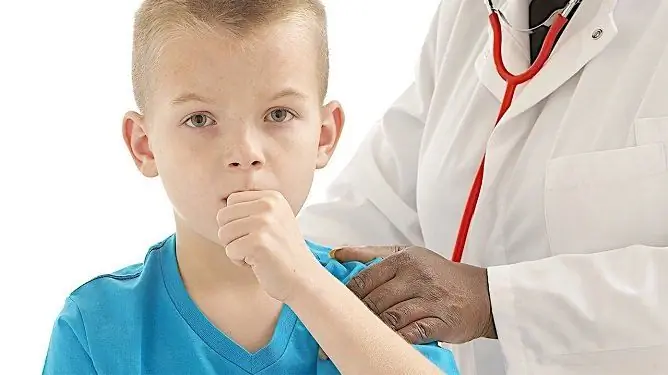- Author Rachel Wainwright [email protected].
- Public 2023-12-15 07:39.
- Last modified 2025-11-02 20:14.
Again ARVI. How to effectively fight viruses?
Runny nose, cough, tears for no reason, complaints that the head and throat hurts, such a familiar picture. "Everything is clear, - the parents conclude. - The kid caught a cold." And tensely remember when and where he got his feet wet when he got cold. All this can really weaken the baby's body, reduce resistance to infections, but remember: the virus is the direct culprit of the disease. And the doctor in these cases diagnoses ARVI (acute respiratory viral disease).

Source: depositphotos.com
Features of viral diseases
It is not always possible to determine from the clinical picture which group of viruses the disease is caused by, because most of them are characterized by common signs all the same runny nose, cough …
- Adenovirals last quite a long time, up to two weeks, while the child has a severe runny nose, conjunctivitis, and sometimes a cough.
- Parainfluenza often affects the larynx, the voice becomes hoarse, sometimes disappearing completely, and the cough is barking, rough. It is parainfluenza that gives such a serious complication as false croup.
- Influenza usually occurs with a very high fever, headache, aches throughout the body. At the onset of the disease, the child may not have a cough or a runny nose.
- Enteroviral fevers are more common in the spring; they are also characterized by high fever, pain in muscles, abdomen.
Unlike, for example, measles or chickenpox, immunity after ARVI is unstable. And if a child is weakened by another illness or a stressful situation, then ordinary hypothermia can become a provocateur of ARVI. In addition, many viruses "fly" in the dry air in the kindergarten during the heating season. This fall, according to the forecasts of the World Health Organization, for example, an increased activity of three strains of influenza is expected at once:
- A / California / 7/2009 (H1N1) virus varieties - "swine" flu;
- B / Brisbane / 60/2008 virus varieties;
- varieties of influenza A / Hong Kong / 4801/2014 (H3N2) virus.
So parents should be on the lookout. With acute respiratory viral infections and influenza, local immunity is primarily reduced and the so-called nasopharyngeal ring suffers: tonsils, lymphoid tissue of the nasopharynx, epithelium of the upper respiratory tract. A runny nose, a cough, a sore throat begins, and the temperature often rises. ARVI is dangerous primarily due to complications. In order to avoid them, it is necessary to seriously and intensively treat the child.
Parental delusions and their consequences
There is a common saying: "If a runny nose is treated, it goes away in a week, and if not treated in seven days." But alas, this is not entirely true, especially with regard to children.
Another common belief is that at the first sign of a cold, and even more so when the temperature rises, antibiotics should be given immediately. But this is a fundamentally wrong decision, because antibacterial drugs only act on bacteria, and they are powerless against viruses! But if antiviral drugs are ignored and not taken on time, then there may well be the following outcome - a bacterial infection will appear on days 4-5, and then antibiotics will be required.
But the onset of this moment can be prevented if you start taking antiviral drugs. In the early stages of influenza and acute respiratory viral infections, a child can be given, for example, children's forms of the drug "Citovir-3" as a curative and antiviral agent, instructions for which are available on the drug's website. Positive conclusions about the effectiveness and safety of the drug were given by the Research Institute of Influenza of the Russian Academy of Medical Sciences, the Research Institute of Children's Infections of the Ministry of Health of the Russian Federation, the Research Institute of Experimental Medicine of the Russian Academy of Medical Sciences and many others. Especially for children, "Tsitovir-3" is produced in the form of a powder without taste or with three fruit flavors to choose from: orange, cranberry and strawberry. Please note that Citovir-3 powder is safe for allergy sufferers and can be given to children from 1 year old.
How does the body fight viruses?

The main constituents of "Citovir-3" are ascorbic acid, bendazole and alpha-glutamyl-tryptophan. And they all work together as a complex antiviral drug: it stimulates the antioxidant system and immunity, enhances the production of natural interferon by the body, and activates the natural mechanisms of antiviral defense.
Scientists have calculated that the prophylactic adoption of children's forms of "Tsitovir-3" increases the body's resistance to infection with ARVI pathogens up to 5 times, negates the lingering forms of ARVI. And taking it in the first hours after infection reduces the period of the disease, the likelihood of complications in the form of pneumonia and acute bronchitis.
Thus, according to the researchers, Citovir- 3 powder is an effective medicinal antiviral agent, which is perfect for treating influenza A and B, acute respiratory viral infections in children when the first symptoms appear, and for prophylaxis in order to strengthen the immune system.

Found a mistake in the text? Select it and press Ctrl + Enter.






